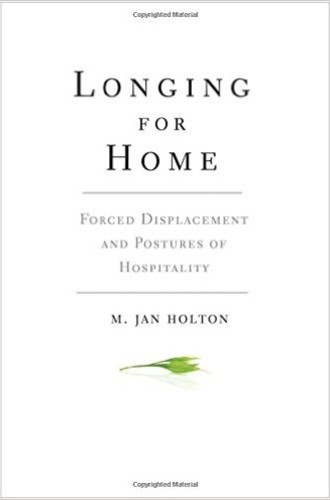The presence of “the other” creates a crisis in any society or community. M. Jan Holton’s book appears at a time when Americans not only face this crisis but intensify it through our social practices of inhospitality. Holton has written a compelling book for our context, albeit in a somewhat whimsical style.
Holton frames her book with two visions. First, she views home as a place of security and a relationship of belonging. Together, place and relationship create an environment for making meaning and maintaining identity.
Her second vision, religion, is dimmer. It functions largely as a positive shadow throughout the book, without much explication. She speaks only vaguely about “sacred stories in the Judeo-Christian tradition.” But she articulates clearly that the language of belonging is faithfulness. To be far from home, then, is to be at risk amid a lack of faithfulness. Holton’s terms—security, belonging, identity-making, and relationship—envision home as a habitat that enables a person to be fully human.
Read our latest issue or browse back issues.
The heart of the book is a study of four populations that have become, in various ways, stranger, foreigner, or outsider. Every displaced person yearns for the belonging and security promised by home. Holton is well situated to report on these social realities because she has done extensive work with the Lost Boys of Sudan, the Batwa people of Uganda, and homeless women in the United States. Her practical experience comes through in the passion and compassion of her truth telling.
Holton’s first case study concerns the Batwa “pygmies” of Uganda, who were systematically displaced from their forest and now live in scattered locations across central Africa. The Batwa people regard the forest as their home and the “natural world as a gift to be respected and lived with cooperatively.” They thrive on a “cosmic economy of sharing” and are remote from the competitive modes of more modernized life. Holton highlights the pressures of development on the Batwa people, as well as the harm done by evangelistic missionaries who attempt to “rescue them” from their “primitive” ways.
The second case study examines internally displaced persons, those who are denied membership and belonging within their own lands. Sometimes internal displacement results from predatory political and economic policies, as with the hopelessly poor. Sometimes it results from natural disasters, such as a tsunami. Sometimes it results from war, as in South Sudan. Internally displaced persons lose the benefits of belonging when their status is suddenly changed from citizen to outsider or foreigner.
Holton, who taught pastoral care and counseling at Yale Divinity School, brings illuminating theory to the habits of those who lack belonging. She engages with John Bowlby’s theory of attachment, D. W. Winnicott’s notion of the holding environment, and Judith Herman’s exposition of posttraumatic stress disorder. Holton focuses her discussion of these theorists within a third case study: returning military veterans in the United States who are rendered outsiders by their experiences of war and being trained to kill. Holton notes that PTSD is a socially constructed diagnosis, the imposition of which often adds to a veteran’s sense of displacement. The imposed label itself creates what may be an unwelcome moral status.
Fourth, Holton considers the chronically homeless in the United States, particularly women. When she served at an overnight crisis-care center Holton witnessed the acute stress of such circumstances. She learned that the epidemic incarceration of African-American men produces people without rights or social relationships. She saw the ways in which a durable state of homelessness disrupts meaningful social relationships and abets the development of other disorders. Summarizing the crisis, Holton quotes Anthony Giddens: “The ontological security which modernity has purchased, on the level of day-to-day routines, depends on an institutional exclusion of social life from fundamental existential issues which raise central moral dilemmas for human beings.” We generate “comfort zones” to avoid thinking seriously about the moral dimensions of homelessness.
The only effective and valid response to this social crisis is to practice hospitality at every level of social relationship. Reflection on the moral and theological groundings of our social relationships could give the concept of hospitality significant staying power. For example, a theological grounding could recast otherness as a legitimate mode of existence rather than a threat. Holton alludes to the possibility of such groundings, but she does not explicate them.
The Bible scholar in me observes that Holton’s project could be enriched by paying attention to the emergence within scriptural study of the concept of forced migration. The term forced migration, now used in place of the more benign exile, reveals the aggressiveness behind the forcible displacement and expulsion of people. The mildness of our typical Bible reading needs to be tempered by the harsh realities shared by the ancient world and our present world.
Holton’s book was written before the current wave of xenophobia in the United States or the recent wave of displaced persons into Europe from the Middle East. But it provides a lens for better understanding the reality that now besets us. Holton directs us toward more responsible discernment of social reality and more active engagement on behalf of the displaced.






